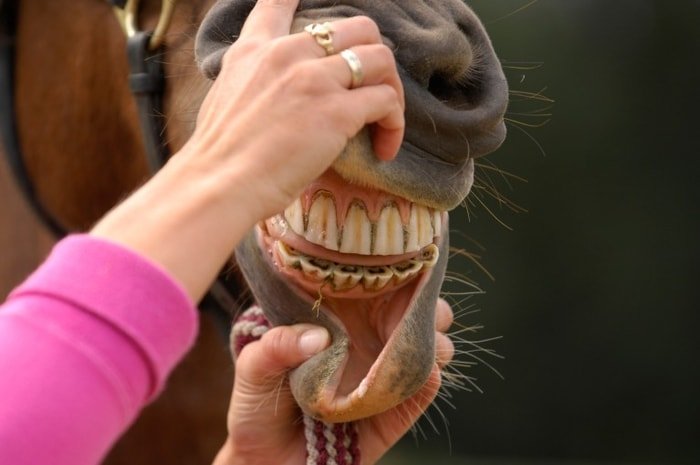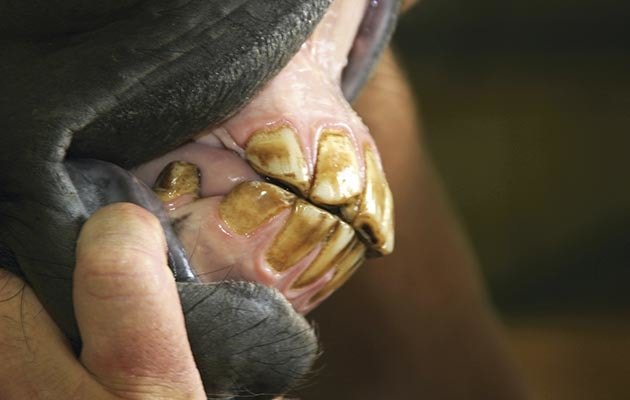The horse’s teeth, unlike those of men or dogs, do not grow to a certain length and remain so. On the contrary, they continue to grow and be worn away until old age. As horses get older, definite changes are observed in the shape and appearance of horse dentition, and it is owing to these that they form such an excellent guide to an animal’s age.
Horse Dentition and Aging
The horse’s age may be determined with practical accuracy by the appearance of the incisor teeth. There are two complete sets of these: the original temporary milk or foal teeth, subsequently replaced by permanent or horse teeth.
Difference Between Temporary and Permanent Teeth
The differences between temporary and permanent teeth are as follows:
- The temporary teeth are small and white, have a distinct neck, and have a short fang, which practically disappears as the teeth age, from the precursor of the growing permanent teeth beneath until its remnant is pushed out of the jaw.
- The permanent teeth are larger, stronger, and browner in color; they have no marked neck and a long and stout fang.
Parts of a Horse Teeth
The parts of a horse tooth are as follows:
- Table or Wearing Surface: The surface that bites on the food or its companion in the opposite jaw is the table or wearing surface.
- The Tooth Mark: The mark is the blackened depression seen on the table. A distinct, narrow, pearly-white ring of enamel lines it. This letter is easily seen and felt as it stands up a little above the level of the rest of the surface. In a new tooth, the mark is comprehensive and deep, but with age and wear, it becomes shallower and smaller until, finally, it disappears altogether.
- Crown: The crown of the tooth is that part above the gum, and the point where the gum and tooth meet is the neck.
- Fang: The fang is the fart within the jaw. It is hollow, and its cavity contains the blood vessels and nerves that nourish and sensitize the tooth. As the tooth grows up, the fang-hole becomes filled in with tooth substances of a lighter color than the remainder, and when wear reaches this level, it appears on the table of the tooth as a small white spot in the center, or in front of the mark, that has not already disappeared.
Number of Horse Teeth
There are six incisors, at first milk teeth (temporary) and later replaced by permanent teeth, in each jaw. The two in the center of the jaw are called centrals; the next tooth on either side is known as a “lateral,” and the outermost tooth on each side of the jaw is the “corner” tooth.
In the male, a tush appears behind the corner tooth on both sides of each jaw when the horse matures. This is for permanent teeth only.
There are six molar teeth on each side of the jaws. The 1st, 2nd, and 3rd are temporary and permanent, but the 4th, 5th, and 6th only appear as permanent teeth. Practically, they may be left out of consideration for our purpose.
Dentition and Aging in Horses
Dentition and aging in horses are closely related, as a horse’s teeth can provide valuable information about its age. Horses have a unique dental system that allows veterinarians and equine experts to estimate a horse’s age with reasonable accuracy by examining the eruption and wear patterns of their teeth. Here’s an overview of how dentition is used to age horses:
- Deciduous (Baby) Teeth: Like humans, horses are born with deciduous or baby teeth, eventually falling out as permanent teeth replace them. Horses have 24 deciduous teeth, also known as “milk teeth,” that appear shortly after birth and are usually all in place when the foal is a few weeks old.
- Permanent Teeth: Horses have a total of 40 permanent teeth, and these teeth continue to erupt and change in shape throughout the horse’s life. There are several critical sets of permanent teeth that veterinarians and equine professionals use to estimate a horse’s age:
- Incisors: The front teeth in a horse’s mouth are the incisors, the most commonly used teeth for aging. There are three sets of incisors on each side of the upper and lower jaws: central, intermediate, and corner incisors. The central incisors are the first to erupt, and their appearance and wear patterns can help determine a horse’s age.
- Canines: Horses also have canine teeth, typically in males and some mares. These teeth tend to erupt between 4 and 5 years of age.
- Premolars and Molars: These are the cheek teeth located towards the back of the horse’s mouth. These teeth can also provide age-related information through their eruption and wear patterns.
- Aging a Horse by Its Teeth: To estimate a horse’s age using its teeth, equine professionals look at various characteristics, including the shape, size, and wear of the incisors. Here are some general guidelines:
- Central Incisors:
- One year: Central incisors are usually fully erupted.
- Two years: Central incisors appear more squared.
- Three years: Central incisors show a slight triangular shape.
- Four years: Central incisors become more rectangular.
- Five years: Central incisors are fully rectangular.
- Corner Incisors:
- Six years: Corner incisors show signs of wear and become oval-shaped.
- Seven years: Corner incisors continue to wear, and the oval shape remains.
- Eight years and older: Corner incisors become more triangular and show increasing wear.
- Other Teeth: Beyond the incisors, the eruption and wear patterns of the other teeth, such as canines, premolars, and molars, can provide additional information to refine the horse’s age estimate.
- Central Incisors:
Final Talk on Horse Dentition
In summary, a thorough understanding of horse dentition is essential for horse owners, veterinarians, and equine professionals. It helps in assessing the overall health and age of horses, allowing for proper dental care and management as horses age. However, for precise age determination, a combination of methods and careful examination is often necessary.

